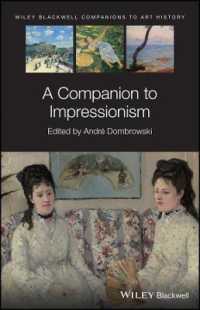- ホーム
- > 洋書
- > 英文書
- > History / World
Full Description
Mapping Space, Sense, and Movement in Florence explores the potential of digital mapping or Historical GIS as a research and teaching tool to enable researchers and students to uncover the spatial, kinetic and sensory dimensions of the early modern city.
The exploration focuses on new digital research and mapping projects that engage the rich social, cultural, and artistic life of Florence in particular. One is a new GIS tool known as DECIMA, (Digitally-Encoded Census Information and Mapping Archive), and the other is a smartphone app called Hidden Florence. The international collaborators who have helped build these and other projects address three questions: how such projects can be created when there are typically fewer sources than for modern cities; how they facilitate more collaborative models for historical research into social relations, senses, and emotions; and how they help us interrogate older historical interpretations and create new models of analysis and communication. Four authors examine technical issues around the software programs and manuscripts. Five then describe how GIS can be used to advance and develop existing research projects. Finally, four authors look to the future and consider how digital mapping transforms the communication of research results, and makes it possible to envision new directions in research.
This exciting new volume is illustrated throughout with maps, screenshots and diagrams to show the projects at work. It will be essential reading for students and scholars of early modern Italy, the Renaissance and digital humanities.
Contents
Mapping Sense, Space and Movement in Florence: Historical GIS and the Early Modern City List of Figures List of Tables Abbreviations Acknowledgements List of Contributors Introduction Nicholas Terpstra Thinking and Using DECIMA: Neighbourhoods and Occupations in Renaissance Florence Colin Rose The Route of Governmentality: Surveying and Collecting Urban Space in Ducal Florence Leah Faibisoff From the Decima to the DECIMA and Back Again: the Data Behind the Data Eduardo Fabbro Shaping the Streetscape: Institutions as Landlords in Early Modern Florence Daniel Jamison Women Behind Walls: Tracking Nuns and Socio-Spatial Networks in Sixteenth-Century Florence Sharon Strocchia and Julia Rombough Locating the Sex Trade in the Early Modern City: Space, Sense, and Regulation in Sixteenth Century Florence Nicholas Terpstra Plague and the City: Methodological Considerations in Mapping Disease in Early Modern Florence John Henderson and Colin Rose Seeing Sound: Mapping the Florentine Soundscape Niall Atkinson Mapping Fear: Plague and Perception in Florence & Tuscany Nicholas A. Eckstein Locating Experience in the Renaissance City Using Mobile App Technologies: The Hidden Florence Project Fabrizio Nevola and David Rosenthal Conclusion: Towards Early Modern Spatial Humanities








